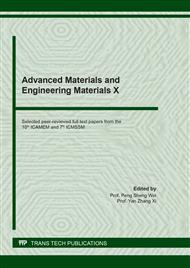[1]
U. Dahlborg, M. Calvo-Dahlborg, P.S. Popel, V.E. Sidorov, Structure and properties of some glass-forming liquid alloys, Eur. Phys. J. B 14 (2000), 639–648.
DOI: 10.1007/s100510051073
Google Scholar
[2]
M. Calvo-Dahlborg, P.S. Popel, M.J. Kramer, M. Besser, J.R. Morris, U. Dahlborg, Superheat-dependent microstructure of molten Al-Si alloys of different compositions studied by small angle neutron scattering, J. Alloys Comp. 550 (2013) 9–22.
DOI: 10.1016/j.jallcom.2012.09.086
Google Scholar
[3]
P.G. Debenedetti, Metastable liquids. Concepts and principles, Princeton University Press, Princeton, (1996).
Google Scholar
[4]
H. Tanaka, General view of a liquid-liquid phase transition, Phys. Rev. E 62 (2000) 6968 – 6976.
DOI: 10.1103/physreve.62.6968
Google Scholar
[5]
Y. He, J. Li, J. Wang, H. Kou, E. Beagunon, Liquid-liquid structure transition and nucleation in undercooled Co-B eutectic alloys, Appl. Phys. A 123 (2017) 391.
DOI: 10.1007/s00339-017-0984-4
Google Scholar
[6]
X. Zhao, C. Wang, H. Zheng, Z. Tian, L. Hu, The role of liquid-liquid transition in glass formation of CuZr alloys, Phys. Chem. Chem. Phys. 19 (2018) 15962–15972.
DOI: 10.1039/c7cp02111a
Google Scholar
[7]
X.F. Li, X.M. Zhao, F. Zhang, F.Q. Zu, W. Zhou, Effect of liquid-liquid phase transition on solidification and wettability of Sn-0.7Cu-xBi solder, Kovove Mater. 54 (2016) 205–210.
DOI: 10.4149/km_2016_3_205
Google Scholar
[8]
X. Li, F. Zu, L. Liu, J. Li, J. Chen, C. Hu, Effect of Sn on reversibility of liquid-liquid transition in Bi-Sb-Sn alloys, J. Alloys Comp. 453 (2008) 508–512.
DOI: 10.1016/j.jallcom.2007.06.127
Google Scholar
[9]
V.S. Tsepelev, Yu.N. Starodubtsev, Nanocrystalline soft magnetic iron-based materials from liquid state to ready product, Nanomatarials, 11 (2021) 00108.
DOI: 10.3390/nano11010108
Google Scholar
[10]
V. Tsepelev, V. Konashkov, Y. Starodubtsev, Y. Belozerov, D. Gaipisherov, Optimum regime of heat treatment of soft magnetic amorphous materials, IEEE Trans. Magn. 48 (2012) 1327–1330.
DOI: 10.1109/tmag.2011.2175209
Google Scholar
[11]
J. Frenkel, Kinetic theory of liquids, Dover Publications, New York, (1946).
Google Scholar
[12]
A.L. Beľtyukov, O.Yu. Goncharov, V.I. Laďyanov, Features of polytherms of the viscosity of Fe-B melts, Rus. J. Phys. Chem. 91 (2017) 1919–(1924).
DOI: 10.1134/s0036024417100065
Google Scholar
[13]
B. Dong, S. Zhou, J. Qin, Y. Li, H. Chen, Y. Wang, The hidden disintegration of cluster heterogeneity in Fe-based glass-forming, Prog. Nat. Sci.: Mater. 28 (2018) 696–703.
DOI: 10.1016/j.pnsc.2018.09.005
Google Scholar
[14]
Y.A. Kochetkova, Y.N. Starodubtsev, V.S. Tsepelev, Kinematic viscosity of melt prepared from an amorphous Fe72.5Cu1Nb2Mo1.5Si14B9 ribbon, IOP Conf. Ser.: Mater. Sci. Eng. 969 (2020) 012027.
DOI: 10.1088/1757-899x/969/1/012027
Google Scholar
[15]
J.M. Ziman, Electrons and phonons. The theory of transport phenomena of solids, Clarendon Press, Oxford, (1960).
Google Scholar


